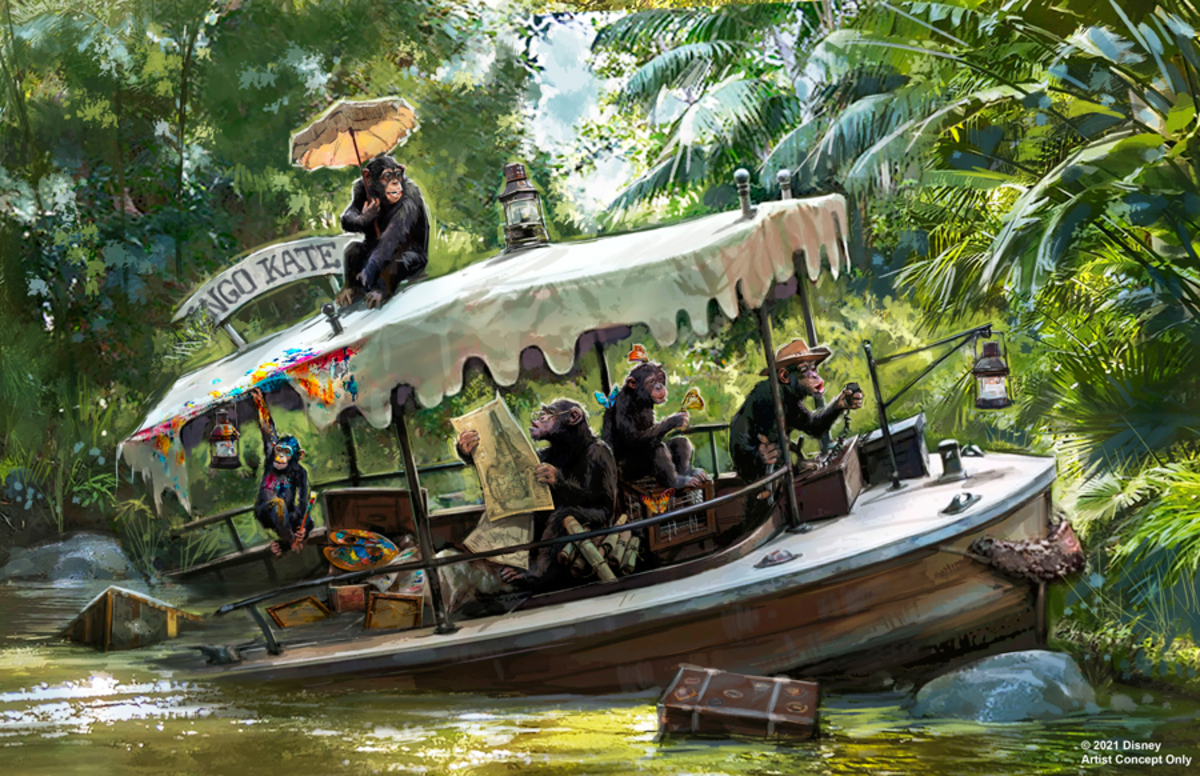Disneyland Revamps Problematic Jungle Cruise Ride Ahead of Movie Premiere
Jungle Cruise joins several rides that will be updated for today's parkgoers.

Parkgoers at Disneyland and Disneyworld have long criticized the popular Jungle Cruise ride for its racist and offensive depictions of Indigenous people. And now, nearly 66 years after Disneyland’s inaugural opening day in 1955, the legacy ride has finally been revamped. It’s been a long battle for Disney fans, as Jungle Cruise has been one of the park’s oldest and most enduring experiences. But the combination of culture shifts and a new movie inspired by the ride have pushed the park into the future.
Disney’s Jungle Cruise, an action adventure film starring Dwayne Johnson and Emily Blunt, hits theaters and streaming on July 30th, and with it comes the newly redesigned Jungle Cruise attraction, which has replaced its offensive portrayals of Indigenous people with more humorous animatronics that center on wildlife run amok. Disney has pivoted the ride to focus on the antics of monkeys and chimpanzees, who can now be seen playing with butterfly crates and messing with the Jungle Cruise expedition.
Jeanette Lomboy, the vice president who oversees the Disneyland Resort and Aulani, a resort in Hawaii, for Imagineering, had a personal connection to the iconic ride. She began working at Disneyland as a ride operator in 1995, which marked the first year that the park allowed women to play Jungle Cruise boat skippers. “Women weren’t allowed to be Jungle Cruise skippers, … To be honest, that I couldn’t be a Jungle Cruise skipper wasn’t something I realized when I was little. That, to me, was a shock. … Women weren’t even allowed to work on the Jungle Cruise. But that to me is progressive change, and you move along.”
Lomboy also addressed the strong emotional attachment that fans have to every inch of the parks. “Disneyland, in particular, is one of those places that belongs to everybody,” Lomboy said. “It’s in their memories. You can’t move a bench without touching someone’s memory. Maybe that bench was where a kid took their first steps or where someone proposed.”
But Disneyland isn’t immune to progress and necessary revisions, much of which is inspired by their own content. As the Mouse House creates films like Coco, Moana, and Black Panther (all of which center on BIPOC characters), the park is expected to incorporate these worlds into their theme parks and merchandise. It’s the rare case of corporate synergy meeting inclusivity, two worlds that rarely, if ever, overlap.
“We wouldn’t have the ability to celebrate Día de los Muertos if Pixar hadn’t created Coco for us,” said Susana Tubert, Disneyland’s creative director of live entertainment. She added, “So in some ways what’s happening, especially at Disney California Adventure Park, is we have been given this library — Black Panther — that are deliberately and intentionally bringing to life different narratives.”
Tubert described the updated Jungle Cruise, which pivots to mocking an international group of explorers as opposed to the Natives. “We found a way to get more comedy built into the ride, … We got to put skippers into unexpected, unprecedented situations, and at the end of the ride the discovery we made was that the animals had the last laugh — not the humans.”
In addition to the Jungle Cruise overhaul, Disney is set to remove the Song of the South references in Splash Mountain, replacing them with a narrative around The Princess and the Frog. The ride will focus on Princess Tiana, the first Black Disney princess.
Carmen Smith, the executive who heads inclusion strategies for Imagineering, said “We are very mindful of the events that are happening around the world that impact people, … The murder of George Floyd — the world responded to that in unique ways. From neighborhoods to communities to cities, states, governments and the corporate world, there was an international response. How can we be part of the healing journey of America? How can we be at our best? We want to make sure that everyone who comes to our parks is seen and that they’re heard.”
Smith added, “When we look at something and realize the content is inappropriate, and may perpetuate a misconception or a stereotype, our intention is to take a look at it critically, and figure out a way to enhance it, to make the necessary changes so it is relevant … It’s about arming people with knowledge, it’s about recognizing the attachment that people have, and understanding the intention was never to make anyone feel uncomfortable. But when we recognize that, we must address it.”
Of course, there will still be manufactured outrage from Fox News and conservatives gunning for a culture war. These people scream into the void about these updates “ruining their childhood”, while ignoring the generations of children after them that want to see themselves reflected in the park.
(via LA Times, image: Disney Park Blog/Disney)
Want more stories like this? Become a subscriber and support the site!
—The Mary Sue has a strict comment policy that forbids, but is not limited to, personal insults toward anyone, hate speech, and trolling.—
Have a tip we should know? tips@themarysue.com